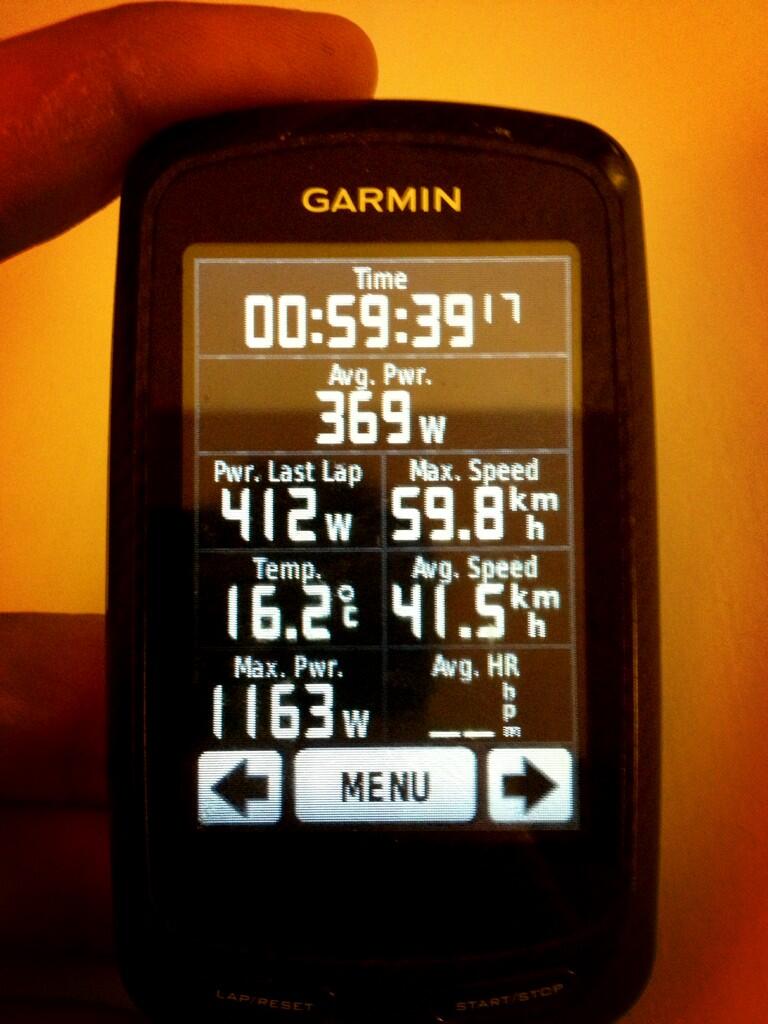There is a huge difference between a Continental Cup
and a World Cup. The main difference is
more than 150 watts average riding the bicycle.
That is the difference in power between Alistair Brownlee and our young
elite competitors in a 40k ride of an Olympic distance triathlon. We thank Felipe Barraza for posting values
regarding the Continental Cup at Dallas (2014):
Resumen
Distancia:
|
24.64
mi
|
Tiempo:
|
57:10
|
Velocidad
media:
|
25.9
mph
|
Altura
ganada:
|
686 ft
|
Calorías:
|
635 C
|
Temperatura
media:
|
89.9 °F
|
Detalles
Tiempo
Tiempo:
|
57:10
|
Tiempo
en movimiento:
|
57:09
|
Elapsed
Time:
|
1:40:07
|
Velocidad
media:
|
25.9
mph
|
Avg
Moving Speed:
|
25.9
mph
|
Velocidad
máxima:
|
37.5
mph
|
Speed
Pace
Altura
Altura
ganada:
|
686 ft
|
Altura
perdida:
|
689 ft
|
Altura
mínima:
|
348 ft
|
Altura
máxima:
|
394 ft
|
Potencia
Potencia
media:
|
187 W
|
Potencia
máxima:
|
1,034 W
|
Max Avg
Power (20 min):
|
200 W
|
Equilibrio
izquierda/derecha:
|
47/53 %
|
Normalized
Power (NP):
|
209 W
|
Intensity
Factor (IF):
|
1.045
|
Training
Stress Score (TSS):
|
102.8
|
Configuración
de la potencia de umbral funcional (FTP):
|
200 W
|
Work:
|
638 kJ
|
The Dallas’ power output has nothing to do with what
is produced in a World Cup when Brownlee and Gómez are pulling the leading
peloton. We have shown several measures
posted by Jan Frodeno that shows his average during a race, it is well above
350 watts even though he is not leading the first peloton which is going faster.
22 avr. 2013
We will try to answer the above question. Jan Frodeno has giving us interesting information
regarding the effort done during the last two competitions. For Frodeno, the effort was the same at San
Diego and Auckland (changed a wheel and kept with the first pack). 370 watts average during the 40k bike,
meaning he had the same power in a hilly course as in the flat course.
Frodeno's power Auckland
The bike was harder in San Diego compared to Auckland for Frodeno!
Different training protocols are required for the two courses. Jan is a heavy guy for a triathlete and going
up hills requires extra watts, he used the same watts without lifting his
weight in San Diego; meaning that he was giving more work to the ones behind
him (Jan was one of the ones pushing the pace at the chasing packs). 370 watts is the limit for the majority of
the triathletes competing in these races to have a “wet run.” Whoever kept hidden longer in the second pack
led by Frodeno was able to run faster at the end. The ones that stayed with Brownlee were not
able to run because they just kept “closing the gaps;” and as a consequence,
they could not do a “wet run.” Please
see previous post:
11 mars 2013
Of course, this strategy works for second, third place, but not for the
champion: Brownlee.
What does it mean?
Our athletes cannot run after the bike when increasing the bike work
during the race because their Functional Capacity is around 200. We had had a 20k time trial of a female
triathlete averaging 188 watts on a flat surface at a pace of 38k/hr. Felipe was drafting in the peloton and his
average speed was 41k/hr. Weight on a
flat surface is not important as we can see on the formula below:
It takes years to improve biking power, equal to the
time needed for running below 30min the 10k or swimming following the first
pack. We are at the level of Continental
Cups with our triathletes. Laurent Vidal has published similar values as the ones posted by Frodeno. The Functional Capacity of the Brownlees and Gómez in triathlon is around 370 watts. Mola and Murray 330 based on the competitive ability, on a flat surface.
The Power Calculator
Your
weight (in kg)
|
|
Bicycle
weight (in kg)
|
|
Bicycle velocity (in km/h)
|
|
Headwind velocity (in km/h)
|
|
Air density (in kg/m3)
|
|
Effective frontal area (in m2)
|
|
Coefficient
of rolling resistance
|
|
Road
Slope (in %)
|
|
Gravitation
(in m/s2)
|
|
Required Total Power (in Watt)
|
|
- Power to fight air resistance
|
|
- Power
to fight gravity
|



Aucun commentaire:
Enregistrer un commentaire